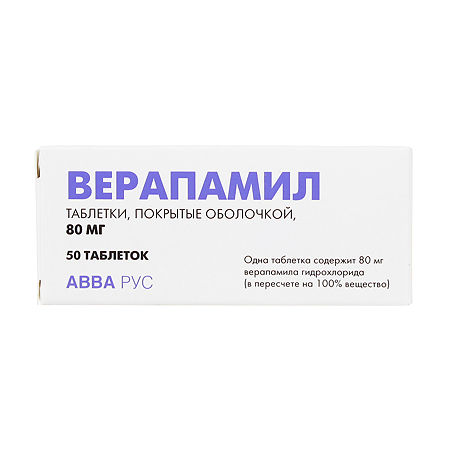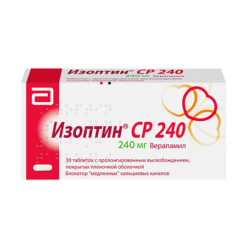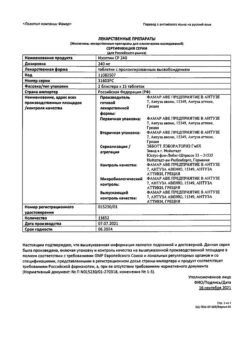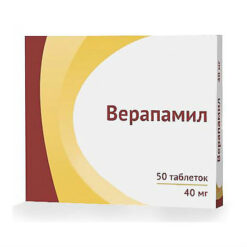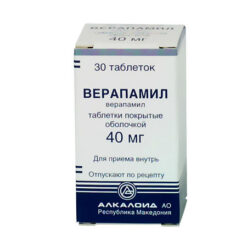No products in the cart.
Verapamil, 80 mg 50 pcs
€1.00
Out of stock
(E-mail when Stock is available)
Description
Selective class I calcium channel blocker, diphenylalkylamine derivative. It has antianginal, antiarrhythmic and antihypertensive effect.
The antianginal effect is connected both with direct action on myocardium and with influence on peripheral hemodynamics (decreases peripheral arterial tone, PPS). The blockade of calcium influx into the cell leads to a decrease in the transformation of the energy contained in ATP macroergic bonds into mechanical work, and decreases myocardial contractility. It reduces myocardial oxygen demand, has vasodilatory, negative and chronotropic effects.
Verapamil significantly reduces AV conduction, prolongs the refractory period and suppresses sinus node automatism. It increases the period of diastolic relaxation of the left ventricle, reduces myocardial wall tone (it is an adjuvant in the treatment of hypertrophic obstructive cardiomyopathy). It has antiarrhythmic effect in supraventricular arrhythmias.
Pharmacokinetics.
In oral administration, more than 90% of the dose is absorbed. Protein binding is 90%. Subjected to metabolism during “first passage” through the liver. The main metabolite is norverapamil, which has less pronounced hypotensive activity than unchanged verapamil.
The T1/2 is 2.8-7.4 hours when a single dose is taken and 4.5-12 hours when repeated doses are taken (due to saturation of liver enzyme systems and increased plasma concentration of verapamil). After intravenous injection the initial T1/2 is about 4 minutes, the final one is 2-5 hours.
It is eliminated mainly by the kidneys and 9-16% through the intestine.
Indications
Indications
Treatment and prevention of CHD: chronic stable angina (angina pectoris), unstable angina pectoris, vasospastic angina pectoris (Prinzmetal/variant angina pectoris).
The treatment and prevention of cardiac rhythm disorders: paroxysmal supraventricular tachycardia, chronic form of atrial flutter and fibrillation (tachyarrhythmic version), supraventricular extrasystoles.
Arterial hypertension. Hypertensive crisis.
Hypertrophic cardiomyopathy.
Active ingredient
Active ingredient
How to take, the dosage
How to take, the dosage
Individual. Orally in adults – in the initial dose of 40-80 mg 3 times per day. For prolonged-acting dosage forms, the single dose should be increased and the frequency of administration decreased. For children aged 6-14 years, 80-360 mg/day, under 6 years, 40-60 mg/day; the frequency of administration is 3-4 times/day.
If necessary, verapamil may be administered by IV fluids (slowly, under control of BP, HR and ECG). The single dose for adults is 5-10 mg, and if there is no effect, the same dose may be administered again after 20 minutes. The single dose for children aged 6-14 years is 2.5-3.5 mg, 1-5 years – 2-3 mg, up to 1 year – 0.75-2 mg. For patients with significant liver dysfunction, the daily dose of verapamil should not exceed 120 mg.
The maximum daily dose for adults when taken orally is 480 mg.
Interaction
Interaction
In concomitant use with antihypertensive drugs (vasodilators, thiazide diuretics, ACE inhibitors) there is a mutual enhancement of antihypertensive effect.
In concomitant use with beta-adrenoblockers, antiarrhythmic agents, agents for inhalation anesthesia, the risk of bradycardia, AV-blockade, severe arterial hypotension, heart failure increases due to the mutual increase of suppressive effect on sinoatrial node automatism and AV conductivity, myocardial contractility and conduction.
Parenteral administration of verapamil in patients who have recently received beta-adrenoblockers carries the risk of arterial hypotension and asystole.
Concomitant use with nitrates increases the antianginal effect of verapamil.
Concomitant use with aliskiren increases its plasma concentrations and the risk of side effects.
Concomitant use with amiodarone increases negative inotropic effects, bradycardia, conduction disorders, AV blockade.
Inasmuch as verapamil inhibits CYP3A4 isoenzyme, which is involved in metabolism of atorvastatin, lovastatin and simvastatin, theoretically there can be cases of drug interaction caused by increasing plasma concentrations of statins. Cases of rhabdomyolysis have been described.
In concomitant use with acetylsalicylic acid there have been described cases of increased bleeding time due to the additive antiplatelet effect.
Concomitant use with buspirone increases plasma concentrations of buspirone, increasing its therapeutic and side effects.
Concomitant administration of verapamil and dantrolene (IV) has resulted in fatal ventricular fibrillation in experimental animals. This combination is potentially dangerous.
In concomitant use with digoxin, cases of increased plasma concentrations of digitoxin have been described.
Concomitant use with digoxin increases the plasma concentration of digoxin.
In concomitant use with disopyramide severe arterial hypotension and collapse are possible, especially in patients with cardiomyopathy or decompensated heart failure. The risk of severe drug interactions appears to be associated with increased negative inotropic action.
Concomitant use with diclofenac decreases plasma concentrations of verapamil; with doxorubicin increases plasma concentrations of doxorubicin and increases its effectiveness.
Concomitant use with imipramine increases the plasma concentration of imipramine and increases the risk of adverse ECG changes. Verapamil increases the bioavailability of imipramine by reducing its clearance. ECG changes are due to increased plasma concentration of imipramine and additive suppressive effect of verapamil and imipramine on AV conductivity.
Concomitant use with carbamazepine potentiates the effects of carbamazepine and increases the risk of CNS side effects due to inhibition of carbamazepine metabolism in the liver by verapamil.
In concomitant use with clonidine, there have been cases of cardiac arrest in patients with arterial hypertension.
Enhances plasma concentration of colchicine (substrate of CYP3A isoenzyme and P-glycoprotein).
In concomitant use with lithium carbonate the manifestations of drug interaction are ambiguous and unpredictable. There have been described cases of increasing the effects of lithium and the development of neurotoxicity, decreased plasma concentrations of lithium and severe bradycardia.
The vasodilatory effect of alpha-adrenoblockers and calcium channel blockers may be additive or synergistic. If terazosin or prazosin and verapamil are used concomitantly, the development of severe arterial hypotension is partially due to pharmacokinetic interaction: increase in Cmax and AUC of terazosin and prazosin.
Concomitant use of rifampicin induces liver enzyme activity, accelerating the metabolism of verapamil, which leads to a decrease in its clinical efficacy.
Concomitant use with sertindol increases the risk of ventricular arrhythmias, especially pirouette-type ventricular arrhythmias.
Theophylline plasma concentrations are increased with concomitant use.
Concomitant use with tubocurarine chloride, vecuronium chloride may increase the myorelaxant effect.
Concomitant use with phenytoin, phenobarbital may significantly decrease plasma concentrations of verapamil.
Concomitant use with fluoxetine increases the side effects of verapamil due to the slowing of its metabolism under the influence of fluoxetine.
Concomitant use decreases clearance of quinidine, increases its plasma concentrations and increases the risk of side effects. There have been cases of arterial hypotension.
In concomitant use verapamil inhibits cyclosporine metabolism in the liver, which leads to decreased excretion and increased plasma concentrations. This is accompanied by intensification of immunosuppressive action, manifestations of nephrotoxicity are decreased.
Concomitant use with cimetidine increases the effects of verapamil.
Concomitant use with enflurane may prolong anesthesia.
Concomitant use with etomidate increases the duration of anesthesia.
Special Instructions
Special Instructions
With caution, use in Grade I AV blockade, bradycardia, severe aortic stenosis, chronic heart failure, mild to moderate arterial hypotension, in the acute phase of myocardial infarction, obstructive hypertrophic cardiomyopathy, hepatic and/or renal failure, in elderly patients, in children and adolescents under 18 years (effectiveness and safety of use have not been studied).
If necessary, combined therapy of angina and arterial hypertension with verapamil and beta-adrenoblockers is possible. However, IV administration of beta-adrenoblockers with verapamil should be avoided.
Impact on ability to drive and operate machinery
After taking verapamil individual reactions (drowsiness, dizziness) affecting the patient’s ability to perform work requiring high concentration and speed of psychomotor reactions are possible.
Contraindications
Contraindications
Side effects
Side effects
Cardiovascular system: bradycardia (less than 50 bpm), marked BP decrease, development or worsening of heart failure, tachycardia; rarely – angina pectoris, up to and including myocardial infarction (especially in patients with severe obstructive coronary artery disease), arrhythmia (including ventricular fibrillation).including ventricular fibrillation and torsade de pointes); when rapidly injected intravenously – AV-blockade of degree III, asystole, collapse.
CNS and peripheral nervous system disorders: dizziness, headache, fainting, anxiety, lethargy, fatigue, asthenia, somnolence, depression, extrapyramidal disorders (ataxia, mask-like face, shuffling gait, stiff arms or legs, trembling hands and fingers, difficulty swallowing).
Digestive system disorders: nausea, constipation (rarely – diarrhea), gum hyperplasia (bleeding, soreness, swelling), increased appetite, increased liver transaminases and alkaline phosphatase activity.
Allergic reactions: skin itching, skin rash, facial hyperemia, erythema multiforme (including Stevens-Johnson syndrome).
Others: weight gain, very rare – agranulocytosis, gynecomastia, hyperprolactinemia, galactorrhea, arthritis, transient loss of vision at maximum plasma concentrations (when given intravenously), pulmonary edema, asymptomatic thrombocytopenia, peripheral edema.
Similarities
Similarities
Additional information
| Shelf life | 3 years. |
|---|---|
| Conditions of storage | In a dry place at a temperature not exceeding 25 °C. Keep out of reach of children. |
| Manufacturer | Avva Rus, Russia |
| Medication form | pills |
| Brand | Avva Rus |
Other forms…
Related products
Buy Verapamil, 80 mg 50 pcs with delivery to USA, UK, Europe and over 120 other countries.

